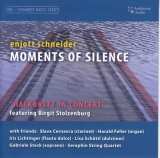Das Hackbrett ist eine Art Kastenzither, deren Saiten mit Klöppeln angeschlagen werden. Es soll ursprünglich aus dem persischen Raum stammen und hat sich von dort über den ganzen Erdball ausgebreitet, als Santur, YanQin, Cymbalum, Tambal, Dulcimer oder Salterio. Unter der deutschen Bezeichnung Hackbrett gruppiert man die Instrumente, die in der alpenländischen Volksmusik beheimatet sind.
Während im Ausland innerhalb großer Kulturräume mehr oder weniger ähnliche Stimmungen verwendet werden, gibt es in den Alpenländern mehrere Stimmungen, chromatische und diatonische. Christoph Willibald Gluck, Leopold Mozart und Antonio Vivaldi verwendeten das Instrument. Und jetzt eben auch Enjott Schneider, von dem auf dieser CD 10 Werke mit Hackbrettern in verschiedenen Ausführungen enthalten sind, Tenor- bez. Kontrabass-Hackbrett. Schneider sagt, das Hackbrett sei wie geschaffen, « um zur Stille zu finden ». Er assoziiert das Instrument mit Klarinette, Sopranstimme, Orgel und – sehr apart und reizvoll – mit dem Streichquartett, färbt die Musik westlich und orientalisch und schafft so eine mystisch-spirituelle Atmosphäre.
Ganz besonders interessant klingt das Pantalon, ein überdimensionales Hackbrett, das von Pantaleon Hebenstreit gebaut wurde und unter den Händen von Birgit Stolzenburg sehr sonor klingt. Während die meisten Kompositionen ruhig fließen, ist das wunderbare Saltarello aus der Brugheliana-Suite sehr tänzerisch und fordert von den hier zwei Solisten am Tenor- und am Kontrabass-Hackbrett ein spezielles Klangempfinden. Sehr originell und klangmalerisch sind die drei Tondichtungen Prayers…From the Hells of War, inspiriert von der Tragödie des Syrien-Kriegs, und darunter ganz besonders das zweite Stück, The Starving Child, mit neben Orgel und Hackbrett auch einer mit Ghost-Soprano bezeichneten Stimme.
Und so ist dies eine sehr aparte CD, die unter den rezenten Veröffentlichungen, die wir besprechen konnten, eine besondere Stellung einnimmt und Enjott Schneiders ungebrochen blühende Einfallskraft zeigt, in Werken die zwischen 1991 und 2018 entstanden sind.
The Hackbrett is a type of zither in a box whose strings are struck with mallets. It is said to have originated in Persia and spread from there across the globe as the santur, yanqin, cymbalum, tambal, dulcimer or salterio. Under the German designation Hackbrett one groups the instruments belonging to the alpine folk music.
While more or less the same tuning is used abroad within sometimes very large cultural areas, in the Alps there are several tunings, chromatic and diatonic. Christoph Willibald Gluck, Leopold Mozart and Antonio Vivaldi used the instrument, and now Enjott Schneider as well. For this CD he reunited 10 works with the Hackbrett in different versions, tenor and double bass Hackbrett. Schneider says that the Hackbrett or dulcimer is made « to find silence ». He associates the instrument with clarinet, soprano voice, organ and – very apart and charming – with the string quartet, coloring the music western and oriental, and creating a mystical-spiritual atmosphere.
The pantalon, an oversized dulcimer built by Pantaleon Hebenstreit and being very sonorous in Birgit Stolzenburg’s performance, sounds particularly interesting. While most of the compositions flow calmly, the wonderful Saltarello from the Brugheliana Suite is very dance-like and demands a special sense of sound creation from the two soloists here on the tenor and double bass dulcimer. The three original and immediately appealing tone poems Prayers…From the Hells of War are inspired by the tragedy of the Syrian war. Especially the second piece is very attractive, The Starving Child, with, in addition to organ and dulcimer, a voice designated as ghost soprano.
And so this is a very distinctive CD among the recent releases we have had the opportunity to review, showing Enjott Schneider’s unbroken, flourishing inventiveness in works written between 1991 and 2018.
























